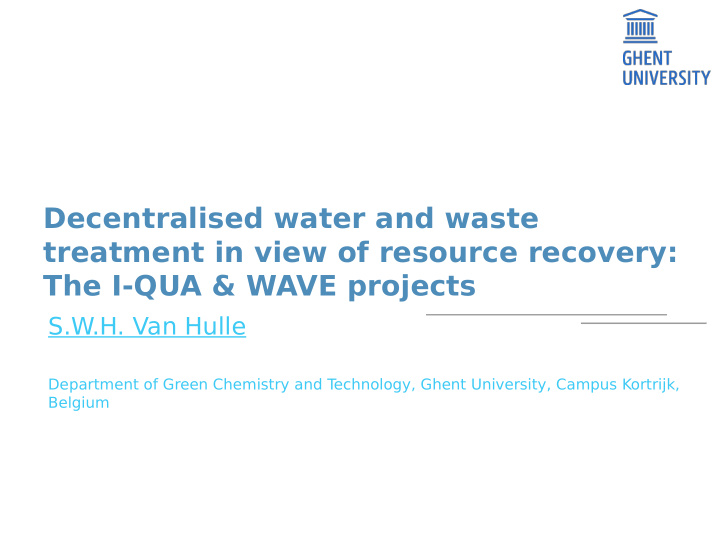



Decentralised water and waste treatment in view of resource recovery: The I-QUA & WAVE projects S.W.H. Van Hulle Department of Green Chemistry and T echnology, Ghent University, Campus Kortrijk, Belgium
(De)centralised water treatment Sharma, A. K., Tjandraatmadja, G., Cook, S., & Gardner, T. (2013). Decentralised systems–definition and drivers in the current context. Water Science and Technology , 67 (9), 2091-2101. 2
(De)centralised water treatment • Reduced cost for infrastructure ▫ E.g. case in Flanders: pressure sewer over +/- 900 m (height difgerence of 3,5 m): +/- 800 euro/m = 750 000 euro! 3
(De)centralised water treatment • Reduced treatment effjciency 4
Decentralised water treatment • Belgian/Flemish situation: zoning plan ▫ Some rural areas: high amount of decentralised treatment 6
Decentralised water treatment • E.g. Catering businesses ▫ A: with treatment ▫ B&C: no treatment • Limits: ▫ BOD < 25 mgO 2 /l, ▫ SS < 60 mg/l 7
Decentralised water treatment • E.g. music festivals DO (mg/l) 12 2004 2005 2006 2007 2008 10 8 6 4 2 0 22-Ιουν 2-Ιουλ 12-Ιουλ 22-Ιουλ 1-Αυγ 11-Αυγ Date 8
Decentralised water treatment • E.g. music festivals 9
Decentralised water treatment • T ackling the challenges ▫ I-Qua: decentralised water treatment demo project ▫ WAVE: sustainable operation of music festivals 10
WAVE 11
IQUA • 5 demo cases in Flanders (B) and The Netherlands: ▫ Restaurant (B) ▫ Goatfarm (B) ▫ Mobile wetland (B) ▫ Integrated treatment football infrastructure (Nl) ▫ Carwash (Nl) 13
Mobile wetland • 15 m³ mobile treatment system (vertical fmow) • Lava rock substrate 14
Mobile wetland • Challenge tests ▫ Flow Q: 4 -> 8 -> 12 -> 16 m³/d HRT: 3,8 -> 1,9 -> 1,3 -> 0,9 d ▫ Winter period (+/- 10°C): no N/dN ▫ Settled municipal waste water: 15
Mobile wetland • Challenge tests ▫ COD/SS Good removal (> 80%, except COD at 16 m³/d) 16
Mobile wetland • Challenge tests ▫ COD/SS Average removal (all HRT) Parameter Infmuent Effmuent % Removal NTU 93,1 3 96,7 BOD (mg/l) 160,8 7,2 95,5 COD (mg/l) 215,1 34,6 83,9 TSS (mg/l) 78,4 4,5 94,3 Limit: BOD < 25 mg/l; SS < 60 mg/l 17
Mobile wetland • Actual performance ▫ Grey water ▫ Flow rate and HRT ▫ 76 m³ in total (<-> 44 m³ in 2017) 18
Mobile wetland • Actual performance ▫ Good removal of detergents (+/- 90%) ▫ Fair removal of COD and SS (70%) ▫ Nitrifjcation: NH 4+ ↓ -> 55% TN removal but no NO 3- ↑ ▫ No P removal • Similar operation in 2017 and 2018 ▫ . 19
Goat farm • Current situation ▫ Constructed wetland (with recirculation for N/deN) 21
Goat farm • Removal effjciency (%) ▫ -> extra polishing step for P removal 22
Goat farm • Extra polishing step ▫ Granular fjltration a) Lava rock b) Zeolite c) Wood chips d) Activated Carbon e) AIEX Resin f) IOCG+S g) IOCG. 24
Goat farm • Extra polishing step ▫ IOCG: very good TP removal (and some extra N removal) ▫ Next step: full-scale 25
What is next? • Focus on water re-use in music festivals 26
What is next? • Focus on water re-use in restaurant 27
What is next? • Separate water treatment at football infrasctructure ▫ Grey, yellow, black water treatment 28
What is next? • Maximal water re-use at carwash 29
Thanks to the sponsors 30
Some references • Van Hulle, Stijn, Ghyselbrecht, N., Vermeiren, T., Depuydt, V., & Boeckaert, C. (2012). Individual treatment of hotel and restaurant waste water in rural areas. ENVIRONMENTAL TECHNOLOGY, 33(6), 653–661. • Van Hulle, Stijn, Audenaert, W., Decostere, B., Hogie, J., & Dejans, P . (2008). Sustainable wastewater treatment of temporary events: the Dranouter Music Festival case study. Water Science and T echnology, 58(8), 1653–1657. • . 31
QUESTIONS? 32
Recommend
More recommend